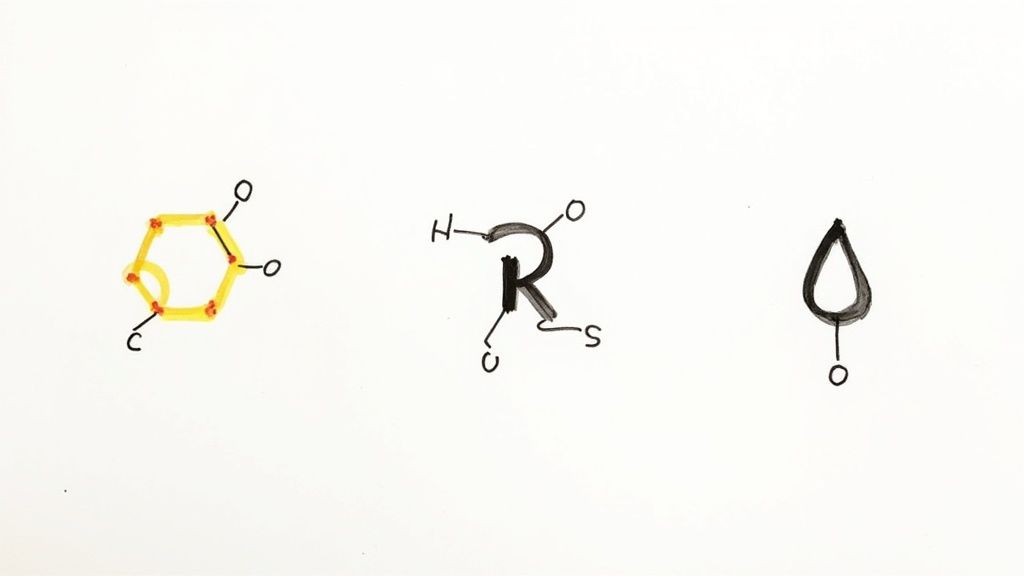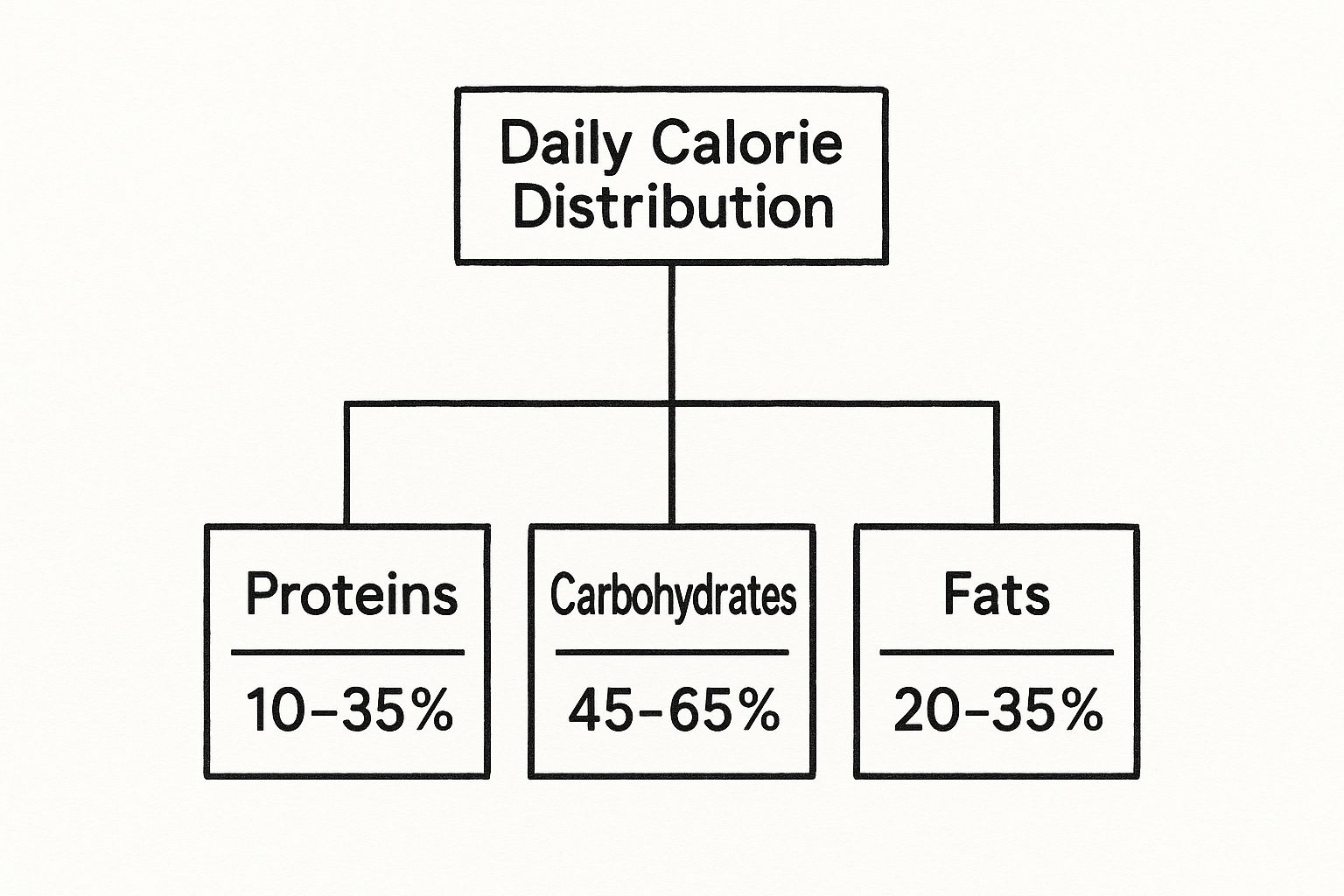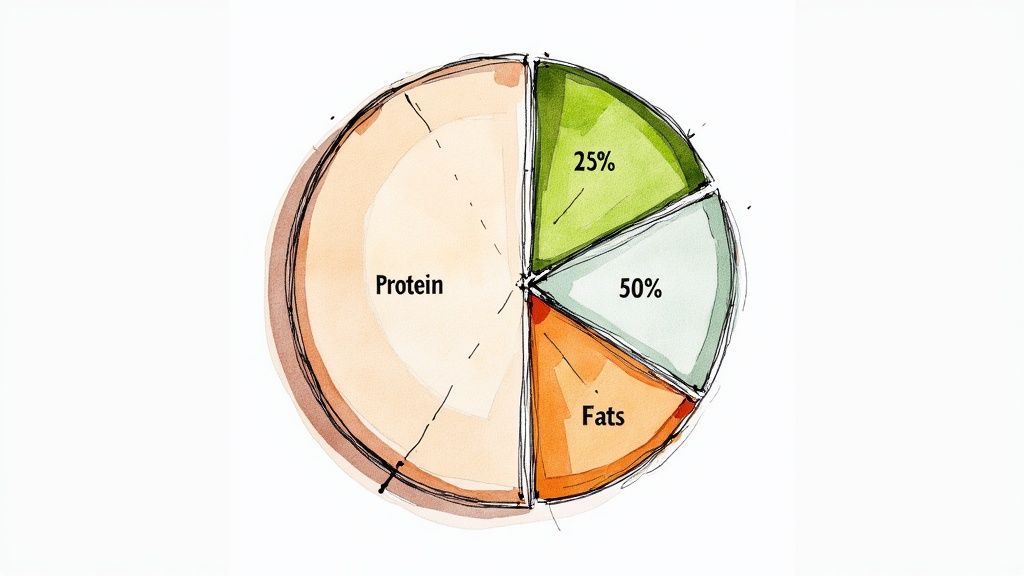What Are Macronutrients? A Simple Guide with Everyday Examples
Learn what are macronutrients examples, including proteins, carbs, and fats, to help you achieve a balanced and healthy lifestyle easily.
Posted by
You've probably heard friends or fitness folks talk about "tracking macros," but what does that even mean? Don't worry, it's not as complicated as it sounds.
Simply put, macronutrients are the three main nutrients your body uses for energy: protein, carbohydrates, and fats. They’re the core fuel that powers everything you do, from crushing a presentation at work to chasing your dog around the park. This guide will break them down with real-world examples of foods you already know and love.
Your Food's Three Building Blocks
Let's cut through the jargon. Every meal you eat—from your morning coffee with a splash of milk to your go-to pasta dinner—is a mix of these three "macros." Understanding what each one does can make a huge difference in how you feel, and you don't need a science degree to get it.
Here’s a fun way to think about it, like building a campfire:
- Carbohydrates are the kindling. They light up fast and give you that quick burst of energy.
- Protein is like the solid logs. It burns steadily, helping to rebuild and sustain the fire.
- Fats are the slow-burning embers, providing long-lasting, reserve energy for later.
Each macro has a vital job, and the goal isn't perfection at every meal. It’s about getting a nice mix of all three throughout your day.
So, Why Bother with Macros Anyway?
Paying a little attention to your macros helps you see the quality of your calories, not just the number. It's a mindset shift from labeling foods as "good" or "bad" to simply understanding how different foods fuel you.
For instance, 200 calories from a handful of almonds (mostly protein and healthy fats) will impact your hunger and energy way differently than 200 calories from a soda (all simple carbs). One gives you sustained fuel; the other gives you a quick sugar rush followed by a crash.
This is where a little casual tracking can be so eye-opening. With an app like munchlog.ai, you don’t have to get lost in numbers. You can just say, "I had a chicken salad for lunch," and instantly see a simple breakdown of the protein, carbs, and fats. It’s all about building awareness, one meal at a time.
Protein: Your Body's Building Crew
Think of your body as a house that's always under construction. Protein is the crew doing all the repairs and renovations. It’s made up of little things called amino acids, which are essential for building muscle, growing healthy hair and nails, and keeping your immune system strong.
And no, you don't have to live on chicken breasts and protein shakes to get enough. Protein is hiding in plain sight in a ton of delicious, everyday foods. You’re probably eating a good amount already without even realizing it.

Common Sources of Protein
Finding protein is easier than you think. It's in meat, dairy, and a whole bunch of awesome plant-based foods. Here are a few examples to look for:
- Lean Meats: Chicken, turkey, and lean cuts of beef.
- Fish and Seafood: Salmon, tuna, shrimp, and cod are all fantastic choices.
- Dairy & Eggs: Greek yogurt, cottage cheese, milk, and of course, whole eggs.
- Plant-Based Powerhouses: Lentils, chickpeas, black beans, tofu, edamame, and quinoa.
- Nuts and Seeds: Almonds, walnuts, chia seeds, and pumpkin seeds are perfect for snacking.
One of the best things about protein is its staying power—it helps you feel full and satisfied for longer. Adding a good source of protein to your meal can be a total game-changer for kicking those mid-afternoon cravings.
The magic happens when you start noticing protein in your daily life. That morning omelet, the lentil soup you had for lunch, or that handful of almonds you grabbed as a snack—they all add up!
Curious how much protein you need? It's different for everyone, but our guide on how to calculate your daily protein needs can help you find a good starting point.
With munchlog.ai, tracking becomes totally effortless. Just tell the app, “I had salmon and asparagus for dinner,” and it does the math for you. You get a clear picture of your protein intake without any tedious typing, making mindful eating simple and stress-free.
Carbohydrates: Your Body's Main Energy Source
Let's clear the air: carbohydrates are not the enemy. They've gotten a bad rap, but carbs are your body's favorite and most efficient source of fuel. Think of them as the gas in your car—they power everything from a tough workout to just thinking clearly at your desk.
The secret isn't to cut carbs out; it's about choosing the right ones for the job. Some give you a quick burst of energy, while others offer a slow, steady stream to keep you feeling full and focused for hours.
How Carbs Fuel Your Day
The great thing about carbs is their variety. A banana before a morning walk? Perfect for a quick energy boost. A hearty bowl of oatmeal for breakfast? That's your ticket to staying focused all the way until lunch.
You're probably already eating plenty of awesome carb sources. Here are a few common examples:
- Grains: Think oatmeal, quinoa, whole-wheat bread, and brown rice. These are your slow-burn energy champs.
- Fruits: Apples, berries, oranges, and bananas offer quick energy plus a healthy dose of vitamins and fiber.
- Starchy Vegetables: Sweet potatoes, corn, and peas are packed with nutrients and provide lasting fuel.
- Legumes: Lentils, chickpeas, and black beans are a powerhouse combo of carbs and protein.
This chart gives you a clear visual of just how central carbohydrates are to a balanced diet.

As you can see, carbs are meant to be the foundation of our daily energy. In fact, most health guidelines recommend that 45% to 65% of your total daily calories come from carbohydrates. They are, quite simply, essential for feeling your best.
Simple vs Complex Carb Examples
To really get a handle on your energy levels, it helps to know the difference between "simple" and "complex" carbs. Here’s a quick breakdown of what that means in everyday foods.
| Carbohydrate Type | What It Does | Everyday Food Examples |
|---|---|---|
| Simple Carbs | Provides a quick burst of energy by breaking down fast. | Fruit, milk, table sugar, honey, soda, candy. |
| Complex Carbs | Offers sustained, long-lasting energy by breaking down slowly. | Oats, brown rice, quinoa, sweet potatoes, beans, lentils. |
Knowing this helps you make smarter choices on the fly. An apple is great for an immediate lift, while building your meals around complex carbs will keep you powered up all day. For a deeper dive, check out our guide on what complex carbohydrates are and examples.
This is where casual tracking makes a huge difference. With munchlog.ai, you can see your carb intake without the headache. Just tell the app, "I had a bowl of oatmeal with blueberries for breakfast," and it instantly translates that into useful info. You'll start to see exactly how your food is fueling you, turning confusion into confidence.
The Truth About Fat: Your Body's Best Friend
Let's get one thing straight: eating fat doesn't make you fat. In fact, your body absolutely needs it to thrive. Healthy fats are crucial for things like hormone production, absorbing vitamins, and keeping your brain sharp. The goal isn't to avoid fat—it's to choose the right kinds.
When we talk about healthy fats, we're talking about the delicious, satisfying stuff that keeps you full and happy. The best part? They're found in everyday foods you probably already love.
Where to Find the Good Fats
You don't have to be a nutritionist to spot the good fats. A simple rule of thumb is to look for fats that come from plants and fish. These are mostly unsaturated fats, and they're fantastic for your health.
Here’s a quick list of some of the best sources:
- Avocados: Creamy, delicious, and perfect on toast or in a salad.
- Olive Oil: A go-to for salad dressings or drizzling over roasted veggies.
- Nuts and Seeds: Almonds, walnuts, chia seeds, and flaxseeds pack a powerful nutritional punch.
- Fatty Fish: Salmon, mackerel, and sardines are loaded with amazing omega-3 fatty acids.
Now, what about saturated fats? You'll find these in things like butter, red meat, and many packaged snacks. They aren't off-limits, but it's a good idea to enjoy them in moderation. It’s all about balance.
The secret is simply being aware of your food choices. Swapping butter for avocado on your toast or choosing grilled salmon instead of steak are small, easy shifts that can make a big difference.
This is exactly where a tool like munchlog.ai is so helpful. When you tell it, “I had a salad with avocado and olive oil dressing,” it does more than just count numbers. It helps you see that you've given your body the high-quality fuel it needs, showing you how healthy fats fit into your day without any stress or guesswork.
How to Build a Balanced Plate
Okay, we’ve covered the big three—protein, carbs, and fat. Now for the fun part: putting them all together on your plate. The goal isn't to hit a perfect ratio every single meal. It's about creating colorful, satisfying meals that make you feel great.
Think of it like building a team for your body. You need a bit of each macronutrient working together to give you steady energy and keep you feeling full. This practical mindset turns nutrition from a stressful numbers game into an enjoyable part of your life.

Visualizing Your Meals
The good news? You can usually spot a balanced meal just by looking at it—no food scale required. Here are a few simple, real-world examples of what this looks like.
Breakfast Idea: A warm bowl of oatmeal (carbs) topped with fresh berries (carbs) and a sprinkle of walnuts (fat/protein). This combo gives you both quick and sustained energy to start your day right.
Lunch Idea: A big quinoa bowl (carbs) filled with grilled chicken (protein), black beans (protein/carbs), and a few slices of creamy avocado (fat).
Dinner Idea: A juicy piece of salmon (protein/fat) served with roasted sweet potatoes (carbs) and a green salad drizzled with olive oil dressing (fat).
See the pattern? Each meal has a source of all three macros. This simple framework is the secret to building nourishing meals that keep you satisfied for hours.
Smart Snacking for Lasting Energy
This balanced approach isn't just for main meals; it’s a game-changer for snacks, too. Combining different macros is how you avoid that dreaded energy crash from a carb-only snack.
A classic example is an apple with a spoonful of peanut butter. The apple gives you quick carbs for an immediate energy lift, while the peanut butter offers protein and fat to make that energy last.
If you’re curious about what the right balance might look like for you, our protein, carb, and fat ratio calculator can be a great starting point.
When you start tracking with munchlog.ai, these patterns will become second nature. By simply telling the app what you ate, you get an instant, clear picture of how balanced your plate is, helping you build a more mindful and stress-free relationship with food.
Frequently Asked Questions About Macronutrients

Diving into macros can bring up a few questions. Let's clear up some of the most common ones so you can feel confident and start eating more mindfully, without the stress.
Do I Need To Track Macros Perfectly Every Day?
Absolutely not! Life is busy, and your food log doesn’t need to be perfect. The goal here is awareness, not obsession.
Think of tracking as a helpful guide, not a strict rulebook. Some days you might eat more carbs, other days more protein—and that's totally fine. What matters is the bigger picture over weeks and months, not getting stressed about one single meal or an "off" day.
How Are Calories and Macros Different?
Great question! Think of calories as the total amount of energy in a food. Macronutrients, on the other hand, tell you where that energy comes from.
It’s like knowing how much gas is in your car versus knowing what type of fuel it is.
- Protein: Has 4 calories per gram.
- Carbohydrates: Also have 4 calories per gram.
- Fat: Is more energy-dense, with 9 calories per gram.
So, while calories give you the total energy number, macros show you the quality and makeup of that energy.
Can I Still Eat My Favorite Foods?
Yes, of course! A healthy and sustainable lifestyle always has room for the foods you love. The point isn't to ban foods but to be more aware of how they fit into your day.
Go ahead and log that slice of pizza or that brownie. Seeing how it fits into your day helps you make other balanced choices without feeling guilty. It’s all about balance, not restriction.
Is One Macronutrient More Important Than Others?
Not really—they’re a team! Each one has a critical and unique job. From building muscle and fueling your brain to supporting your hormones, they all play an essential part in keeping you healthy and energized.
The best approach for most people is a balanced one that includes a healthy mix of all three. That's what creates sustainable, long-term health and keeps you feeling your best.
Ready to stop guessing and start understanding your food? With munchlog.ai, just say what you ate and get instant insights into your protein, carbs, and fats. Start your journey toward effortless food tracking today at munchlog.ai.